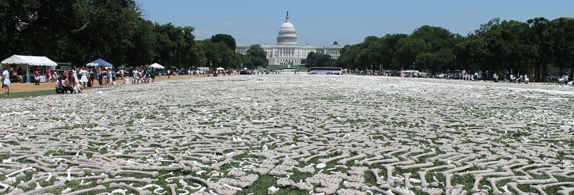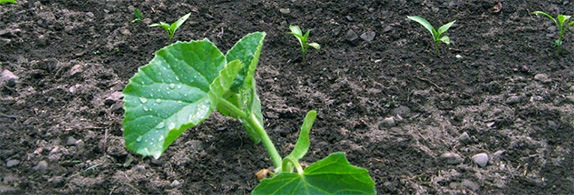One Million Bones

The Washington Mall was covered with handmade bones. From photographs, one could see an ocean of femurs, ribs, skulls, sacrums, all kinds of bones, laid out the grass with a wide white ribbon parting them like a Sea of Mourning.
GigaPan took the most arresting images using its capacity for gigapixel 360 degree moving views. It’s almost unbelievable that something so stunning could be achieved. You can get a great view at the TED blog.
The I,018,260 sculpted, cast, and even knitted bones made by artists and children and volunteers from around the world, went all the way down the mall to the Capital. It was, as the project’s website says, “a collaborative site of conscience,” a “large-scale social art practice,” and an “Act Against Atrocity.” The bones were laid out for two days on the Mall from June 8th to the 10th “as a protest to the unthinkable mass atrocities still taking place in our time in Sudan, South Sudan, the Democratic Republic of the Congo, Burma, Syria, and Somalia.”
Hundreds and hundreds of people, dressed in white, helped place the bones. The first time I saw a photograph of that skeletal ocean, it awakened the aching emotional memories of having grown up in WWII and the Cold War. I think “One Million Bones” must rank among the world’s most poignant, overwhelming, and haunting works of public art ever made.
For everyone who’s psychologically absorbed the genocidal statistics of the conquest of Native American peoples, of WWI, Armenia, WWII and the Holocaust, the Chinese Revolution, Stalinism, the Cold War threat of nuclear annihilation, Cambodia, Ruanda, and the seemingly endless and monstrous acts of “ethnic cleansing” around the world, not to mention all the non-genocidal dirty wars, One Million Bones gets into that dream state fluidity that all great art reaches, that underground stream of being where dreads and losses entangle us so tightly that transcending them, without abandoning them, becomes essential to our nature and the inner tasks of survival.
To experience One Million Bones, even in images, is to know that “killing fields” is not merely a linguistic expression, that the modern age is actually, physically, as contradictory as we think it is – horrible almost beyond imagination, and for those with the luck of the draw, but only those lucky ones, sweeter than any time in history.
The Project was founded and directed by Naomi Natale, and managed by Susan McAllister. Natale is 2011 Arts Healing Network award winner, and 2010 TED Senior Fellow. McAllister, who was director of Albuquerque’s Harwood community arts center, was the the financial director for National Poetry Slam held in Albuquerque. Kathleen McEuen, an Albuquerque native, was the project’s national liason, Leigh Durham was the field organizer, and Olivia Natale coordinated volunteers. A truly masterful job was done by all. Read more about these wonderful women at the project’s website.
One Million Bones will try to find a permanent home in its city of origin, Albuquerque, where some 750,000 of the bones will eventually repose in an as yet undetermined fashion.
When you can actually see a hidden truth, even one hiding in plain sight all around you, a truth you’ve intuited but could never grasp, the feeling of liberation and responsibility are immense. We are liberated from inner dungeons, and embrace the responsibility to affirm that atrocity is not inevitable, and not humankind’s perpetual fate. We must know what it is. We must learn to feel its consequences. Only then we can work against it.
Critters We Have Known: Taco’s long run

Everything in the world is always happening all at once - the sublime, the monstrous, the ephemeral and the profound. And all passing moments are worth the words to say them, but some more than others.
A moment of unbridled enthusiasm and the triumph of joy over misery comes back with the memory of small Yorkie named Taco the Magnificent. He was the living embodiment of the motto: “if you don’t mind, it doesn’t matter.”
In l986, John Cordova and I had taken to running up the Duranes Lateral and along the main drain from the mid-North Valley to the Alameda Bridge – and back – a couple of times a week – about 13 miles round trip.
As John likes to say, that was 40 pounds and many bad joints and disks ago. I doubt if I could even walk it now. One October Saturday, John decided to take his six-pound, irrepressible Yorkie, Taco, with us. It soon became clear that while we were doing a slow half marathon, Taco was doing a very fast full one.
Up and down and around, zooming this way and that, getting too far ahead and roaring back and then taking off again, pink tongue wagging, his zeal and delight never flagging.
Somewhere on the way back, Taco strayed off the path into some weeds and came out covered, and I do mean covered, in burrs. They must have felt horrible. But never a whine or growl came from Taco the Magnificent as he barreled on, up and down and back and forth as if he didn’t have a pain the world.
Only when we got back did we realize how terribly tangled and burred up his coat really was. John used tweezers to pluck out some burrs, but it was too much even for him. So the vet gave Taco a shave and the problem was solved.
Taco didn’t mind. He didn’t mind the burrs. He didn’t mind the shave. They didn’t matter to him. What mattered was being boundless, uninhibited, unrestrained. What mattered was the energy of the universe coursing through his little dog’s body. What mattered to Taco the Magnificent was nothing less than giving each moment, each day, everything he had.
Local Food and Local Compost

For years, when we had very little money, my wife and I lived partially out of our garden. We were small time, amateur, local food growers. Very small time. Very amateur. But in the l970s and l980s, the weather was perfect for growing huge batches of veggies – and even Sunday farmers like us could grow enough squash, corn, string beans, peas, tomatoes, carrots, and onions to eat hardy through the Fall.
We must have been thinking about Victory Gardens in WWII when we planted our first crops in the North Valley somewhere around May l969. I used to think our garden was the most beautiful place in the world. We even had dill forests under which our cats could sleep the afternoon away in languid calm.
It was those Victory Gardens that spurred us on. I remember seeing them all over when I was a toddler in California during the war. Vague memories of neighbors weeding and molding beautiful furrows and mounds on what used to be their front lawns gave me a sense of doing something more than just experimenting in our garden.
I didn’t know it then, but almost 20 million Americans had Victory Gardens and they grew, by some estimates, nearly 40 percent of all the vegetables in the American diet during the war.
If you’ve lived on the economic margins like we have, gardening is much more than a pastime. And now that climate change is upon us, we are experiencing an unprecedented chain reaction that moves through our CO2 producing fossil fuel energy sources all the way into our climate, our drought, and our capacity to feed ourselves.
New Mexico still produces only slightly more than 3 percent of what we eat. Imported food from California, Florida and the Midwest still dominates our markets. But it can’t go on forever. Fuel prices will keep on rising. Temperatures will keep on rising. And localities all over the nation will have to learn how to adapt to their own specific conditions and how to create agricultures or “food sheds” that their people can increasingly depend upon.
There’s something so sensible and so heroically quixotic about nurturing local “food sheds” in this nasty transition from global, back to local, that you just have to support whoever’s doing it. Take La Montanita Co-op for instance. Truthout tells us, in a recent piece entitled The Revolution is Going to be Fought with the Hoe, that 20 percent of the Co-op’s total sales comes from some 1,500 items grown and produced by nearly 900 local groups. The Co-op’s goal is to make 50 percent of its sales from local producers.
These figures tell me that growing and eating local is not wild-eyed pipe dream, but a real possibility, with proper support and enthusiasm.
Which brings me to the notion of large-scale local composting, an idea I just learned about from Gary Paul Nabhan’s piece called Our Coming Food Crisis in the New York Times last week.
Nabhan’s concerned with how local farmers can combat drought and says there are “dozens of time-tested strategies” for doing so, including locally produced municipal compost, and not reconstituted sewer sludge. Naban calls for massively produced soil amendments from cities “being mandated to transition to green-waste sorting and composting, which could then be distributed to nearby farms” instead of “simply generating methane emissions from landfills.”
Nabhan says that “increasing organic matter in fields from 1 percent to 5 percent “can increase water storage in the root zones from 33 pounds per cubic meter to 195 pounds.” That’s a huge water addition.
I’ve seen the sense of this when I’ve used local compost in good quantities from Soilutions, a local composting company in the South Valley that most successful gardeners I know use exclusively for soil amendments. Soilutions, Inc. was founded in l987, by Jim and Karen Brooks of Tijeras, to create the kinds of soils needed to generate permaculture landscapes.
One can see how city or county programs across the state could liberate green waste from landfills and compost it on a massive scale, using local composters in a public/private partnership, gaining a new source of revenue and conserving water. That kind of composting might even become the nutrient for a new wave of Victory Gardens around western cities, which could supply more farmers markets, but also change the political struggle between rural and urban people. When city folk start farming more, even on a tiny scale, its opens them to the political realities of trying to make some kind of living from the land. Maybe there’s hope for old amateur gardeners after all.
Shoved Around by Bigness

The quest for the perfect pen wasn’t helped any when local stationary stores began to fold in the l980s and l990s. As a writer with a need for talismans, touchstones, and any incantations I can get to keep the copy flowing, I’ve been on a fifty-year quest for the perfect pen. I suppose many of us ink stained wretches have been on this very journey.
At least four decades ago, in the early years of the quest, I found a fountain pen nib in the gutter around Central and San Mateo. A highly unlikely sighting. Did it have magic portent? Perhaps. I took the nib to my favorite stationary store – General Office Supply on Gold downtown – wondering what I’d found. They knew immediately. It was an Esterbrook replaceable nib. Esterbrooks were very inexpensive school pens that every kid used. And they had many different kinds of nibs.
Naturally, General Office Supply had a stash of old Esterbrooks, having been in business since at least the l930s. I bought one for next to nothing, screwed in my nib, inked it, and started writing. I still use it to this day.
Imagine trying to do that at Staples, or Office Max, or Office Depot. They, of course, killed off most local stationers, all except the famous Pen and Pad in Hoffmantown. If I found a nib in the gutter today, I’d go straight to them. And they’d know exactly what to do.
Big chains killed off most local bookstores too, of course. The best of the best in the old days were the Living Batch and Salt of the Earth near the University.
Book sellers were like librarians then. When you needed something, they could advise you. The nice folks at Barnes and Noble, and at the late Borders, were charming but could offer no real advice beyond the best sellers. And we get nothing but sales pitches at Amazon. Now the best advice comes from Bookworks, a store staffed by real book people who know books, love books, and know how to get you what you need. And used bookstores like Acequia Books and Bookstop are owned by book masters and scholars.
I can’t gripe about big drugstores. Walgreens is a useful resource. And the pharmacists there give good considered advice, but you can’t build a relationship with their good people, because you don’t know who’s going to be there or when. At the old corner drug store, a customer knew the owner who was also the pharmacist. He was there all the time. His store was part of your neighborhood.
I’ve almost stopped using big banks, no matter how sweet the teller scripts might be. It’s just impossible to establish rapport with their employees because they’re moved around from branch to branch. Why put your money in the hands of people you do not, cannot, and never will know? It’s credit unions now for me. They’re all about being local. And their employees usually don’t call you rudely by your first name when they’ve never laid eyes on you before and are young enough to be your grandchild.
And I haven’t eaten in non-local chain restaurant in years either. Corporate bigness doesn’t respond to customers, it imposes on customers what it wants to sell. It’s a form of economic colonialism. And many of us “locals” want out.
(Creative Commons photos via Flickr: Bones by Elvert Barnes, Yorkie by Berkeley T. Compton, Garden by Ethan Oringel, Pen Nibs by MPClemens.)




Responses to “Provincial Matters, 7-29-2013”